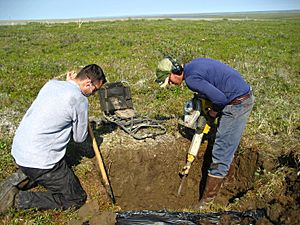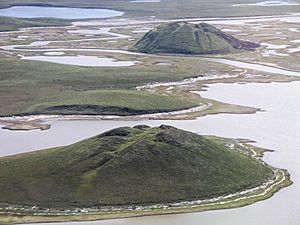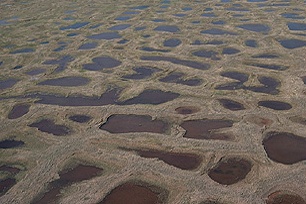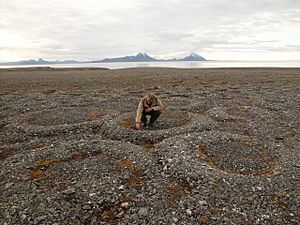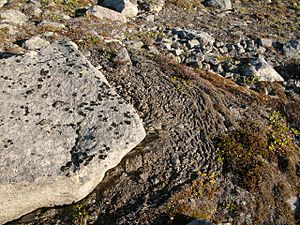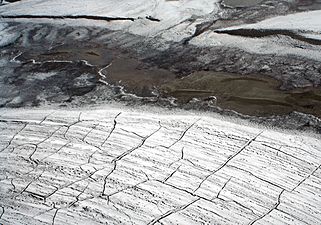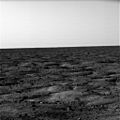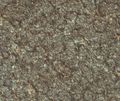Permafrost facts for kids
In geology, permafrost is soil that stays at or below 0 degrees Celsius (32 degrees Fahrenheit) for two or more years. It is also called cryotic soil. Most permafrost is found on land near the North and South poles.
Contents
What are Permafrost Landforms?
Permafrost can create interesting shapes and features on the land. These are called landforms. Some are very large, like palsas and pingos. Others are smaller, like patterned ground. You can find these in cold, icy areas around the world.
-
Pingos near Tuktoyaktuk, Northwest Territories, Canada
-
Stone rings on Spitsbergen
-
Solifluction on Svalbard
-
Cracks forming at the edges of the Storflaket permafrost bog in Sweden.
Palsas and Pingos
Palsas are low, oval-shaped hills or mounds. They form in wet, peaty areas when ice grows inside the ground. This pushes the soil upwards.
Pingos are larger, dome-shaped hills. They have a core of ice. Pingos can be found in flat, wet areas in the Arctic. They look like small mountains rising from the flat land.
Patterned Ground
Patterned ground refers to the unique shapes that appear on the surface of the ground in permafrost areas. These patterns can look like circles, stripes, or polygons (shapes with many sides). They are formed by the freezing and thawing of water in the soil. This movement sorts the soil and rocks into these cool designs.
Ice Wedges
One common type of patterned ground involves ice wedges. These are cracks in the ground that fill with water. When the water freezes, it expands, making the crack wider. Over many years, these cracks grow into large, wedge-shaped ice formations underground. They often create the polygon patterns you see on the surface.
Solifluction
Solifluction is a slow flow of wet soil over frozen ground. When the top layer of permafrost thaws in summer, it becomes very muddy. Because the ground underneath is still frozen, the wet soil cannot drain away. It slowly slides downhill, creating wavy or lobed patterns on slopes.
Images for kids
-
Southern limit of permafrost in Eurasia according to Karl Ernst von Baer (1843), and other authors.
-
A peat plateau complex south of Fort Simpson, Northwest Territories
-
Thawing permafrost in Herschel Island, Canada, 2013
-
Permafrost and ice in Herschel Island, Canada, 2012
-
Permafrost thaw ponds on peatland in Hudson Bay, Canada in 2008.
-
Permafrost polygons on Mars imaged by the Phoenix lander.
-
False-color Mars Reconnaissance Orbiter image of polygonal surface pattern.
-
Heat pipes in vertical supports maintain a frozen bulb around portions of the Trans-Alaska Pipeline that are at risk of thawing.
See also
 In Spanish: Permafrost para niños
In Spanish: Permafrost para niños


